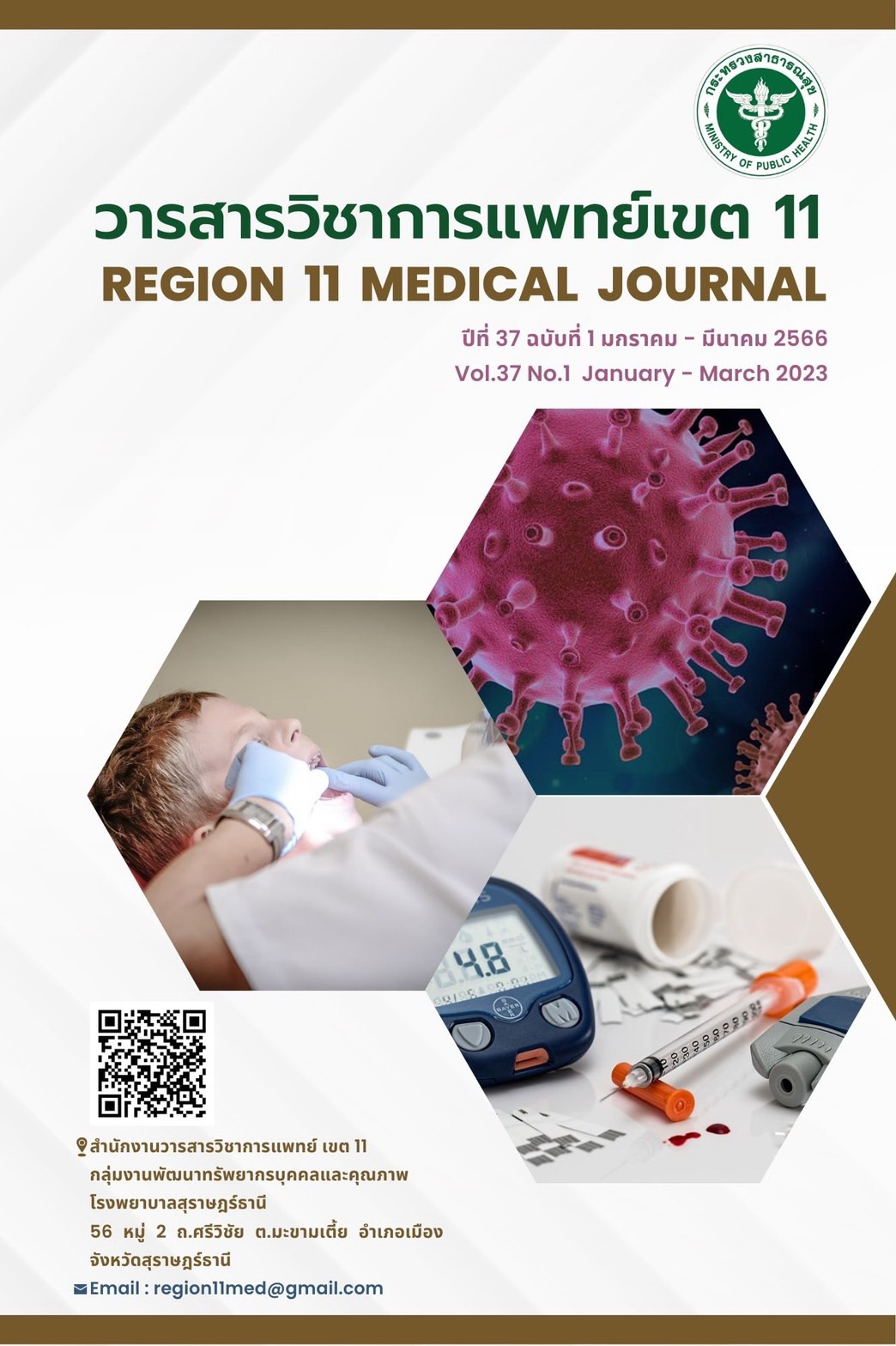Evaluation of accuracy between GAPs, RTS, and ISS to predict Mortality rate in 24 hours among Traumatic Patients, A single trial study
Keywords:
Road Casualty, Mortality Rate, Predictor of mortalityAbstract
Background: Traffic accident has been a leading cause of death worldwide and there is a difference between the violence and the mortality risk of each casualty. By comparing the GCS-Age-SBP scores (GAPs), the Revised Trauma Score (RTS), and the Injury Severity Score (ISS), for the prediction of casualties within 24 hours to find out which tool is most accurate.
Objective: To compare the accuracy in mortality prediction of casualties from traffic accidents between the GAPs, RTS, and ISS.
Methods: The data of road casualties from Tharongchang Hospital from 1 October 2020 to 30 September 2021 were studied, recorded, and statistically analyzed.
Results: From a total of 1,005 road casualties, 956 patients and 49 patients met the inclusion and exclusion criteria respectively. Most of the casualties were 608 males aged 20 to 60. Most accidents involved motorcycles. A large number of the casualties denied a medical condition or drug use. The level of injury severity was semi-urgency and 933 patients survived. The significant risk factors of death within 24 hours were age, mechanisms of injury, drug abuse, anticoagulants use, underlying disease, and emergency severity index level (P-value < 0.05).
Of the 956 patients, 99.9% had an RTS of <11 that should be taken to the Trauma center. 95.7% with a GAPS of 19-25 were in the low-risk group, and these patients’ mortality rate was 2.8%. and 92.2% with an ISS of 1-8 suffered minor injuries. When we analyzed by multi-logistic regression, GAPS, and ISS were the best tool for mortality prediction within 24 hours that was statistically significant due to P-value < 0.05
Conclusion: The GAPs were the best tool for mortality prediction within 24 hours which was statistically significant due to an AUC of ROC 0.998, Standard Error of 0.01, and 95% CI 0.995 – 1.000.
References
World Health Organization. Road traffic injuries fact sheet. สืบค้นจาก: www.who.int/mediacentre/factsheets/fs358/en/. . 2018.
World Health Organization. Global Status report on road Safety 2015. สืบค้นจาก: www. who.int/violence_injury_prevention/ road_safety_status. 2015.
Gruen RL GBSHCPA. Indicators of the quality of trauma care and the performance of trauma systems. Br J Surg 2012. 2012;97–104.
Alghnam S PMHAAM et al. Predicting in-hospital death among patients injured in traffic crashes in Saudi Arabia. Injury. 2014;45:1693–9.
ราชวิทยาลัยศัลยแพทย์แห่งประเทศไทย กระทรวงสาธารณสุข สำนักงานหลักประกันสุขภาพแห่งชาติ สถาบันการแพทย์ฉุกเฉินแห่งชาติ และสถาบันรับรองคุณภาพสถานพยาบาล. คู่มือมาตรฐานการบริบาลผู้บาดเจ็บสำหรับประเทศไทย. http://www.rcst.or.th/web-upload/filecenter/CoverATLS2013-TH.pdf.
Michael F. R et al. Advanced Trauma Life Support Tenth Edition. 9th ed. Saint Clair Street Chicago: American College of Surgeons; 2020.
Najafi Z ZHMA. The accuracy of acuity scoring tools to predict 24-h mortality in traumatic brain injury patients: A guide to triage criteria. Int Emerg Nurse. 2018;36:27–33.
Roy N GMSEVDKMKV et al. Validation of international trauma scoring systems in urban trauma centers in India. centers 2016;47:2459–64.
Chawda MN HFPHGPV. Predicting outcome after multiple trauma: which scoring system? Injury. 2004;35:347–58.
Gonzalez RP CGPHMMRCB. Does increased emergency medical services prehospital time affect patient mortality in rural motor vehicle crashes? Am J Surg 2009. 2009;197:30–4.
Sánchez-Mangas R GFA de JAAAM. The probability of death in road traffic accidents. How important is a quick medical response? Accident Anal? v 2010. 2010;42:1048–56.
Feero S HJSEIL. Does out-of-hospital EMS time affect trauma Survival. . Am J Med . 1995;133–5.
Panomwan W, Charuwan T, Aronrag M, Paibul S. Relation of Factor on Survival Outcomes among Traumatic Patients at the Tertiary care Hospital Admitted for Traffic Accidents in Phuket Province Srinagarind Med J 2019; 34(1): 52-59
Farzad R, Hanieh Ebrahimi B, Samad Shams V, Mehran H and Robab Mehdizadeh E. Evaluation of MGAP and GAP Trauma Scores to Predict Prognosis of Multiple-trauma Patients. Road Traffic Injury Research Center, Tabriz University of Medical Sciences, Tabriz, IR Iran. Trauma Mon. 2017 May; 22(3):e33249.
Samuel M G Jr, Michael M, Pierre B, Roumen V, Matthew J L, Michael G M, Deborah M S, Thomas M S, Jon M H. Correlation Between the Revised Trauma Score and Injury Severity Score: Implications for Prehospital Trauma Triage. Prehospital Emergency Care Vol 23, 2019: 263-270
Chetta Ngamjarus M.Sc., Virasakdi Chongsuvivatwong, Ph.D., Edward McNeil. M.Sc. n4Studies: Sample size calculation for an Epidemiological study on a smart device. Siriraj Medical Journal Vol.68, 2016: 160-170 (https://he02.tci-thaijo.org/index.php/sirirajmedj/article/view/58342/48170)
อุบล ยี่เฮ็ง. การจัดการและการช่วยเหลือผู้บาดเจ็บจากอุบัติเหตุในระยะก่อนถึงโรงพยาบาล. ใน:อนันต์ ตัณมุขยกุล, เรวัฒ ชุณหสุวรรณกุล,พรพรหม เมืองแมน, บรรณาธิการ. ศัลยศาสตร์วิวัฒน์ 40. พิมพ์ครั้งที่ 1. กรุงเทพฯ: เอ็น พี เพรส ลิมิเต็ดพาร์เนอร์ชิพ; 2554
World Health Organization. Road traffic injuries fact sheet [cited February 12, 2018].
ศูนย์ปฏิบัติการกระทรวงสาธารณสุข รายงานสถิติผู้บาดเจ็บจากอุบัติเหตุจราจร ระบบสารสนเทศเพื่อการจัดการผู้บาดเจ็บและเสียชีวิตจากอุบัติเหตุแห่งประเทศไทย. http://ict-pher.moph.go.th/index.php?r=accidents/report&precessid.
สำนักงานระบบบริการการแพทย์ฉุกเฉิน. รายงานสถิติการแพทย์ฉุกเฉิน. https://ws.niems.go.th/items_front/inde
Downloads
Published
How to Cite
Issue
Section
License
Copyright (c) 2022 Region11Medical Journal

This work is licensed under a Creative Commons Attribution-NonCommercial-NoDerivatives 4.0 International License.






